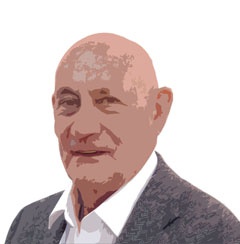Grave concerns : Testing ground anchors
David Francis is a hands-on mason who has specialised for many years on the memorial side of the stone industry. He was Technical Advisor to the National Association of Memorial Masons, writing manuals and City & Guilds Qualifications. If you have an issue regarding any aspect of memorial masonry, David is happy to help. Send your questions or comments to David at nss@qmj.co.uk.
Ever since BS 8415:2012 was published, questions have been raised about the site NAMM uses for the testing of ground anchors used for fixing memorials. It has been suggested that a pit should be dug and filled with sand in order to test the various fixing systems that NAMM accredits.
The matter has been discussed again at a recent British Standards committee meeting for Natural Stones, called to discuss this contentious issue.
The meeting was well attended and included committee members outside the memorial business. The discussion started by reviewing the suggested sand pit and the suitability of the soil at Northampton cemetery used by NAMM for testing.
We were shown two videos, one of a sand pit demonstration (bit.ly/fixing-test) and one of a soil test in Northampton Cemetery (bit.ly/soil-conditions), driving a wooden peg into the ground. The second was intended to show the ground there does not comply with the requirements of BS 8415.
The first video showed a Stone Safe system being pulled beyond the criteria set by NAMM. It continued with a NAMM approved pin in a lawn memorial, in a separate sand pit, being pulled progressively over at less than 70kg. The second video was in the cemetery NAMM use for testing, driving a wooden peg into the ground. The British Standard says ground conditions for testing fixings should be checked by being able to drive a wooden stake into the ground with some difficulty. The video is of a demonstration that aims to show the ground at Northampton does not comply with this condition.
It was stated by one of the committee that using the alternative of a dug pit filled with sand was unacceptable because it is not in any way natural and cannot be guaranteed consistent in density in different pits because the same compactness cannot be achieved every time. Also the sand can be manipulated and water content has an effect. Using fresh, washed and graded sand each time was not considered to be realistic. Naturally occurring sandy soil has a lot of fines and is well settled and compacted. What is required is a piece of ground that is undisturbed and of a soil such as river silt.
One of the masons pointed out that if a cemetery has loose sandy soil a deeper anchor should be used. There are many different types and variations of anchors that give the mason choices. Cemetery offices would know if there was a problem in their cemetery.
The discussion continued, trying to resolve this problem. The conclusion was that the fixer mason should have some guide lines on how to assess the type of ground and the most suitable fixing system to use for his particular memorial.
The committee asked two members to draw up an agenda of topics to be included in the guide lines.
These will be circulated to members of the committee and a meeting held to discuss this and add any new ideas. These guidelines could be included, if approved by British Standards, in the next update of BS 8415. It would be expected the ground anchor manufactures and the NAMM Code of Working Practice would also include the same guidelines as in the Standard.
I believe the battle about the testing pit is over, with the committee agreeing that the pit content can be variable. But it looks as if NAMM might have to find a new site to test fixing system that is more representative of the softer soils found in different parts of the country.
David Francis is a hands-on mason who ran a craft-based business in South London for many years. He moved out of London in the 1990s and since then has been concentrating on memorial masonry, being Technical Advisor and Trainer for the National Association of Memorial Masons (NAMM) for several years, writing training manuals and City & Guild Qualifications. He has now left NAMM but would like to continue to advise and assist masons to help and improve skills in the sector.

